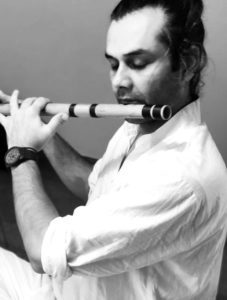“One has to have a good intent for every action and practice equanimity after it,” Shiva said. “Be self-aware and alert like a snake to its surroundings, be aware of what your mind feeds you and you will know how to adapt and evade thoughts that disturb you and bring fear.”
Bhujanga in Sanskrit means ‘snake’. The posture entails keeping the legs in contact with the mat while the torso is pushed up to open the chest. The strength of the bend in the spine can be calibrated with a simultaneous bend in the arms. This posture when performed for an extended period of time is accompanied by a murmured chant ‘OM HIRANYA GARBHAYA NAMAHA’, which means greeting and acknowledging your golden cosmic self.
Bhujanga asana represents a cobra when it is the most alert and aware of its surroundings. This cobra posture represents our ability as humans to face our fears and not shy away from what we dread. The open chest in the posture helps in expanding the lungs for gentle but deep inhalations and exhalations. The hood of the snake is also a representation of the wisdom that is achieved in stillness and helps in conquering our fears.
Lord Shiva’s first pupil was Shakti (Parvati). She insisted on learning yoga from Adiyogi (the first yogi). Lord Shiva, with ‘Karkotaka’ (the serpent) coiled around his neck, spoke to Shakti as a teacher and told her that in the journey of being a yogi it is important to move ahead with faith in the cosmos and the cosmic self. It is also important for a yogi to have a firm resolve and patience. He told her that modesty and purity of thought were the ornaments of any human and more so of a yogi.
Shakti listened to Lord Shiva attentively, but Shiva knew she had a question. He opened his eyes and asked her to say what she had in her mind.
She did not hold back and asked “How does one get rid of fear?”
“You do not have to get rid of fear, you have to be aware of it,” Adiyogi replied.
“One has to have a good intent for every action and practice equanimity after it,” Shiva said. “Be self-aware and alert like a snake to its surroundings, be aware of what your mind feeds you and you will know how to adapt and evade thoughts that disturb you and bring fear.”
Lord Shiva told her that a supple spine and equanimity in thoughts would always help in facing fears.
It is after this discourse Adiyogi taught Shakti Bhujanga asana, an asana for keeping the spine healthy.
Bhujanga asana is always a part of Hatha Yoga practice. It is known for strengthening the spine and its supporting muscles while improving blood circulation. The asana is also revered for the psychosomatic benefits it brings to the practitioner.
OM HIRANYA GARBHAYA NAMAHA
By Ankur Tunaak

Ankur Tunaak has been an Ashtanga yoga practitioner for over a decade, studied with Shree M. Vishwanath who was one of the first students and nephew of Shree Pathabhi Jois. Also, an alumnus of Bihar School Of Yoga, one of four premier Yogic Studies Institutions in India. Ankur is a storyteller and photographer, currently teaching yoga in New Delhi, India.
Start your 14-day Free Trial with Omstars Today!









